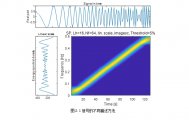自适应时频变换信号检测方法研究

自适应时频变换信号检测方法研究(论文10200字)
摘要:非平稳信号的时频分析是信号处理的一个重要研究方向,本文研究非平稳随机信号的时频分析的方法,介绍传统时频分析方法。在研究线性时频表示及二次时频表示的基础上,分析和研究自适应时频分析理论和方法,包括基于局域波分解的自适应Chirplet时频分析和自适应最优核函数时频分析。并研究了双向高斯核函数时频分析方法,经过matlab仿真后发现以及自适应时频分析可以有效克服线性时频表示和二次时频表示的缺点,消除了交叉项干扰并且可以保持较高的时频聚集度。
关键词:非平稳信号,时频分析,分解式自适应时频分析,双向高斯核函数
Research on Detection Method of Adaptive Time-Frequency Signal
Abstract:Time-frequency analysis is a hotspot in modern signal processing research. This paper aims to study the time-frequency analysis method of non-stationary random signals and briefly describe its development process.Based on the study of linear time-frequency representation and quadratic time-frequency representation, the adaptive time-frequency analysis method is studied, including adaptive Chirplet time-frequency analysis based on local wave decomposition and adaptive optimal kernel function time-frequency analysis.The two-dimensional Gaussian kernel function time-frequency analysis method is studied. After matlab simulation and adaptive time-frequency analysis, it can effectively overcome the shortcomings of linear time-frequency representation and secondary time-frequency representation, eliminate cross-term interference and maintain high Time-frequency aggregation.
Keywords: non-stationary signal, time-frequency analysis, decomposed adaptive time-frequency analysis, two-way Gaussian kernel function

目录
1 引言 1
1.1 课题研究背景和意义 1
1.2 时频分析发展研究现状 1
2 非平稳信号时频分析基本理论 2
2.1 信号的描述方法 2
2.2 Heisenberg-Gabor准则 3
2.3 解析信号 3
2.4 信号的平稳性 4
2.5 时频分析的性质 4
3 非平稳信号线性和二次时频表示 5
3.1 线性时频分析理论及仿真 5
3.1.1 短时傅立叶变换 5
[版权所有:http://DOC163.com]
3.1.2 连续小波变换 8
3.1.3 仿真结果及分析 8
3.2 二次时频分析理论及仿真 11
3.2.1 Wigner-Ville分布 11
3.2.2 Cohen类分布 13
3.2.3 模糊函数 14
3.2.4 仿真结果及分析 15
4 自适应时频分析信号检测 17
4.1 基于信号分解的自适应时频分析原理 17
4.1.1 自适应高斯谱图 17
4.1.2 基函数的选择 19
4.1.3 Chirplet信号分解自适应时频原理 21
4.1.4 仿真结果及分析 22
4.2 最优核自适应时频分析原理 24
4.3 双向高斯核函数的时频分布 25
4.3.1 双向高斯核函设计和性质 25
4.3.2 仿真结果及分析 29
总结 31
参考文献 32
致谢 33 [版权所有:http://DOC163.com]
